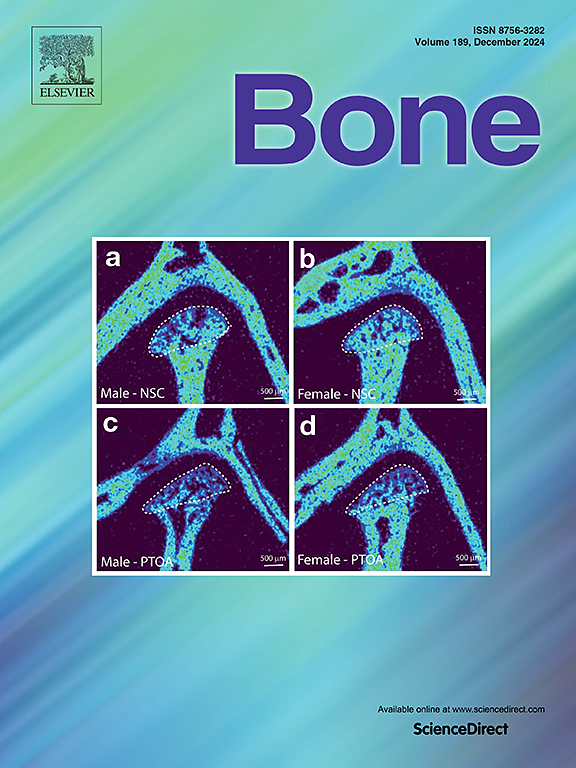载荷方向对兔胫骨载荷模型有限元应变预测的影响
IF 3.6
2区 医学
Q2 ENDOCRINOLOGY & METABOLISM
引用次数: 0
摘要
机械负荷在维持骨的数量和质量方面起着重要的作用。啮齿类动物是最常用的体内负荷模型,用于研究施加的机械负荷与骨适应反应之间的关系,但它们不会自然地表现出类似人类的皮质内重塑。相反,我们小组开发了一种非侵入性的兔胫骨体内负荷模型。本研究旨在开发和验证基于静态等效计算机断层扫描(CT)的兔胫骨有限元模型,以捕捉我们的体内机械加载装置产生的微力学环境。我们进一步研究应变预测对假设力矢量方向变化的敏感性。将20只新西兰大白兔后肢在胫骨上固定应变计花环,进行单轴压缩循环加载。然后在髋关节处拆除后肢,在复制实验装置中使用CT成像,并处理成标本特异性的FE模型。使用数学优化程序确定单个力矢量方向,使有限元预测与实验测量的骨应变之间的误差最小化,从而获得高度精确的应变预测(R2=0.96),在偏差调整后呈现Y= X型关系。与使用各种单一假设取向技术的模型相比,这种方法大大降低了应变预测误差。我们还发现,即使假设后肢方向的轻微偏差也会严重影响应变预测。这些发现表明,实验信息的方法可能对后肢特定加载方向有用。这项工作有助于未来研究利用兔动物模型检查骨适应的力学生物学。本文章由计算机程序翻译,如有差异,请以英文原文为准。

Effect of load orientation on finite element strain predictions in a rabbit tibial loading model
Mechanical loading plays an important role in the maintenance of bone quantity and quality. Rodents are the most frequently used in vivo loading model for examining the relationship between applied mechanical loads and the bone adaptation response, but they do not naturally exhibit human-like intracortical remodeling. Instead, our group has developed a non-invasive in vivo rabbit tibial loading model. This study aimed to develop and validate statically equivalent computed tomography (CT)-based finite element (FE) models of the rabbit tibia to capture the micro-mechanical environment produced by our in vivo mechanical loading device. We further sought to investigate the strain prediction sensitivity to changes in the assumed force vector orientation. Twenty hindlimbs from New Zealand White Rabbits were cyclically loaded in uniaxial compression with strain gauge rosettes affixed to the tibia. The hindlimbs were then disarticulated at the hip, imaged with CT in replica experimental fixtures, and processed into specimen-specific FE models. A mathematical optimization routine was used to determine the individual force vector orientations that minimized the error between FE predicted and experimentally measured bone strains, which yielded highly accurate strain predictions () that exhibited a type of relationship after bias adjustment. This approach resulted in substantially lower strain prediction errors when compared to models using various single assumed orientation techniques. We also found that even slight deviations in the assumed hindlimb orientation substantially affect strain predictions. These findings suggest that experimentally informed approaches may be useful for hindlimb-specific loading orientations. This work serves to enable future studies examining the mechanobiology of bone adaptation using the rabbit animal model.
求助全文
通过发布文献求助,成功后即可免费获取论文全文。
去求助
来源期刊

Bone
医学-内分泌学与代谢
CiteScore
8.90
自引率
4.90%
发文量
264
审稿时长
30 days
期刊介绍:
BONE is an interdisciplinary forum for the rapid publication of original articles and reviews on basic, translational, and clinical aspects of bone and mineral metabolism. The Journal also encourages submissions related to interactions of bone with other organ systems, including cartilage, endocrine, muscle, fat, neural, vascular, gastrointestinal, hematopoietic, and immune systems. Particular attention is placed on the application of experimental studies to clinical practice.
 求助内容:
求助内容: 应助结果提醒方式:
应助结果提醒方式:


